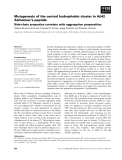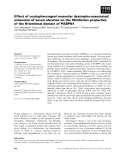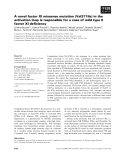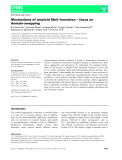
Disorders of hemoglobin
-
Protein misfolding and deposition underlie an increasing number of debili-tating human disorders. Alzheimer’s disease is pathologically characterized by the presence of numerous insoluble amyloid plaques in the brain, com-posed primarily of the 42 amino acid humanb-amyloid peptide (Ab42). Disease-linked mutations in Ab42 occur in or near a central hydrophobic cluster comprising residues 17–21.
 11p
11p  dell39
dell39
 27-03-2013
27-03-2013
 34
34
 3
3
 Download
Download
-
Oculopharyngeal muscular dystrophy (OPMD) is an autosomal dominant disease that usually manifests itself within the fifth decade. The most prom-inent symptoms are progressive ptosis, dysphagia, and proximal limb mus-cle weakness. The disorder is caused by trinucleotide (GCG) expansions in the N-terminal part of the poly(A)-binding protein 1 (PABPN1) that result in the extension of a 10-alanine segment by up to seven more alanines.
 10p
10p  inspiron33
inspiron33
 23-03-2013
23-03-2013
 49
49
 4
4
 Download
Download
-
Lithium is a therapeutic agent commonly used to treat bipolar disorder and its beneficial effects are thought to be due to a combination of activa-tion of the Wnt⁄b-catenin pathway via inhibition of glycogen synthase kin-ase-3b and depletion of the inositol pool via inhibition of the inositol monophosphatase-1.
 17p
17p  galaxyss3
galaxyss3
 19-03-2013
19-03-2013
 23
23
 2
2
 Download
Download
-
The potent immunomodulatory, anti-inflammatory and procoagulant properties of protein no. 4 secreted from the rat seminal vesicle epithelium (SV-IV) have previously been found to be modulated by a supramolecular monomer–trimer equilibrium.
 12p
12p  media19
media19
 05-03-2013
05-03-2013
 36
36
 2
2
 Download
Download
-
Coagulation factor XI (FXI) is the zymogen of a serine protease that, when converted to its active form, contributes to blood coagulation through proteolytic activation of factor IX. FXI deficiency is typically an autosomal recessive disorder, characterized by bleeding symptoms mainly associated with injury or surgery.
 11p
11p  media19
media19
 05-03-2013
05-03-2013
 31
31
 2
2
 Download
Download
-
Conformational diseases constitute a group of heterologous disorders in which a constituent host protein undergoes changes in conformation, lead-ing to aggregation and deposition. To understand the molecular mecha-nisms of the process of amyloid fibril formation, numerousin vitro and in vivo studies, including model and pathologically relevant proteins, have been performed.
 20p
20p  cosis54
cosis54
 05-01-2013
05-01-2013
 33
33
 2
2
 Download
Download
-
Diagnosis When PV presents with erythrocytosis in combination with leukocytosis, thrombocytosis, or both, the diagnosis is apparent. However, when patients present with an elevated hemoglobin or hematocrit alone, or with thrombocytosis alone, the diagnostic evaluation is more complex because of the many diagnostic possibilities (Table 103-2). Furthermore, unless the hemoglobin level is ≥20 gm% (hematocrit ≥60%), it is not possible to distinguish PV from disorders causing plasma volume contraction.
 5p
5p  thanhongan
thanhongan
 07-12-2010
07-12-2010
 84
84
 4
4
 Download
Download
-
Table 101-2 General Features of Hemolytic Disorders General examination Jaundice, pallor Other findings physical Spleen may be enlarged; bossing of skull in severe congenital cases Hemoglobin From normal to severely reduced MCV, MCH Usually increased Reticulocytes Increased Bilirubin Increased (mostly unconjugated) LDH Increased (up to 10X normal with intravascular hemolysis) Haptoglobin Reduced to absent Note: MCV, mean corpuscular volume; MCH, mean corpuscular hemoglobin; LDH, lactate dehydrogenase.
 5p
5p  thanhongan
thanhongan
 07-12-2010
07-12-2010
 69
69
 4
4
 Download
Download
-
Deferasirox is a promising oral iron-chelating agent. Single daily doses of 20 or 30 mg deferasirox produced reductions in liver iron concentration comparable to desferoxamine in chronically transfused adult and pediatric patients. Deferasirox produces some elevations in liver enzymes and slight but persistent increases in serum creatinine, without apparent clinical consequence. Other toxicities are similar to those of desferoxamine. Its toxicity profile is acceptable, although long-term effects are still being evaluated.
 6p
6p  thanhongan
thanhongan
 07-12-2010
07-12-2010
 80
80
 4
4
 Download
Download
-
Hemoglobin E HbE (i.e., α2β226Glu - Lys) is extremely common in Cambodia, Thailand, and Vietnam. The gene has become far more prevalent in the United States as a result of immigration of Asian persons, especially in California, where HbE is the most common variant detected. HbE is mildly unstable but not enough to affect RBC life span significantly. The high frequency of the HbE gene may be a result of the thalassemia phenotype associated with its inheritance. Heterozygotes resemble individuals with mild β-thalassemia trait.
 5p
5p  thanhongan
thanhongan
 07-12-2010
07-12-2010
 90
90
 3
3
 Download
Download
-
Low-affinity hemoglobins should be considered in patients with cyanosis or a low hematocrit with no other reason apparent after thorough evaluation. The P 50 test confirms the diagnosis. Counseling and reassurance are the interventions of choice. Methemoglobin should be suspected in patients with hypoxic symptoms who appear cyanotic but have a Pa O2 sufficiently high that hemoglobin should be fully saturated with oxygen.
 5p
5p  thanhongan
thanhongan
 07-12-2010
07-12-2010
 74
74
 5
5
 Download
Download
-
Unstable hemoglobins occur sporadically, often by spontaneous new mutations. Heterozygotes are often symptomatic because a significant Heinz body burden can develop even when the unstable variant accounts for a portion of the total hemoglobin. Symptomatic unstable hemoglobins tend to be β-globin variants, because sporadic mutations affecting only one of the four α-globins would generate only 20–30% abnormal hemoglobin. Hemoglobins with Altered Oxygen Affinity High-affinity hemoglobins [e.g.
 5p
5p  thanhongan
thanhongan
 07-12-2010
07-12-2010
 71
71
 4
4
 Download
Download
-
Severity is highly variable. Known modulating factors are those that ameliorate the burden of unpaired α-globin inclusions. Alleles associated with milder synthetic defects and co-inheritance of α-thalassemia trait reduce clinical severity by reducing accumulation of excess α globin. HbF persists to various degrees in β-thalassemias. γ-Globin gene chains can substitute for βchains, generating more hemoglobin and reducing the burden of α-globin inclusions. The terms β-thalassemia major and β-thalassemia intermedia are used to reflect the clinical heterogeneity.
 5p
5p  thanhongan
thanhongan
 07-12-2010
07-12-2010
 75
75
 3
3
 Download
Download
-
The homozygous state for the α-thalassemia-1 cis deletion (hydrops fetalis) causes total absence of α-globin synthesis. No physiologically useful hemoglobin is produced beyond the embryonic stage. Excess γ-globin forms tetramers called Hb Barts (γ4), which has a very high oxygen affinity. It delivers almost no O 2 to fetal tissues, causing tissue asphyxia, edema (hydrops fetalis), congestive heart failure, and death in utero. α-Thalassemia-2 trait is common (15–20%) among people of African descent. The cis α-thalassemia-1 deletion is almost never seen, however.
 5p
5p  thanhongan
thanhongan
 07-12-2010
07-12-2010
 84
84
 3
3
 Download
Download
-
Clinical Manifestations of Sickle Cell Trait Sickle cell trait is usually asymptomatic. Anemia and painful crises are exceedingly rare. An uncommon but highly distinctive symptom is painless hematuria often occurring in adolescent males, probably due to papillary necrosis. Isosthenuria is a more common manifestation of the same process. Sloughing of papillae with urethral obstruction has been reported, as have isolated cases of massive sickling or sudden death due to exposure to high altitudes or extremes of exercise and dehydration.
 5p
5p  thanhongan
thanhongan
 07-12-2010
07-12-2010
 74
74
 4
4
 Download
Download
-
Acute chest syndrome is a medical emergency that may require management in an intensive care unit. Hydration should be monitored carefully to avoid the development of pulmonary edema, and oxygen therapy should be especially vigorous for protection of arterial saturation. Diagnostic evaluation for pneumonia and pulmonary embolism should be especially thorough, since these may occur with atypical symptoms.
 6p
6p  thanhongan
thanhongan
 07-12-2010
07-12-2010
 76
76
 3
3
 Download
Download
-
Sickle Cell Syndromes The sickle cell syndromes are caused by a mutation in the β-globin gene that changes the sixth amino acid from glutamic acid to valine. HbS (α2β26 Glu→Va1) polymerizes reversibly when deoxygenated to form a gelatinous network of fibrous polymers that stiffen the RBC membrane, increase viscosity, and cause dehydration due to potassium leakage and calcium influx (Fig. 99-3). These changes also produce the sickle shape. Sickled cells lose the pliability needed to traverse small capillaries.
 5p
5p  thanhongan
thanhongan
 07-12-2010
07-12-2010
 69
69
 2
2
 Download
Download
-
Clinical Manifestations of Sickle Cell Anemia Most patients with sickling syndromes suffer from hemolytic anemia, with hematocrits from 15–30%, and significant reticulocytosis. Anemia was once thought to exert protective effects against vasoocclusion by reducing blood viscosity. However, natural history and drug therapy trials suggest that an increase in the hematocrit and feedback inhibition of reticulocytosis might be beneficial, even at the expense of increased blood viscosity. The role of adhesive reticulocytes in vasoocclusion might account for these paradoxical effects.
 5p
5p  thanhongan
thanhongan
 07-12-2010
07-12-2010
 83
83
 2
2
 Download
Download
-
Harrison's Internal Medicine Chapter 99. Disorders of Hemoglobin Disorders of Hemoglobin: Introduction Hemoglobin is critical for normal oxygen delivery to tissues; it is also present in erythrocytes in such high concentrations that it can alter red cell shape, deformability, and viscosity. Hemoglobinopathies are disorders affecting the structure, function, or production of hemoglobin. These conditions are usually inherited and range in severity from asymptomatic laboratory abnormalities to death in utero.
 5p
5p  thanhongan
thanhongan
 07-12-2010
07-12-2010
 86
86
 8
8
 Download
Download
-
Hemoglobin-oxygen dissociation curve. The hemoglobin tetramer can bind up to four molecules of oxygen in the iron-containing sites of the heme molecules. As oxygen is bound, 2,3-BPG and CO2 are expelled. Salt bridges are broken, and each of the globin molecules changes its conformation to facilitate oxygen binding. Oxygen release to the tissues is the reverse process, salt bridges being formed and 2,3-BPG and CO2 bound. Deoxyhemoglobin does not bind oxygen efficiently until the cell returns to conditions of higher pH, the most important modulator of O2 affinity (Bohr effect).
 5p
5p  thanhongan
thanhongan
 07-12-2010
07-12-2010
 80
80
 4
4
 Download
Download
CHỦ ĐỀ BẠN MUỐN TÌM
































